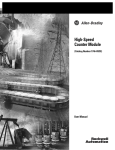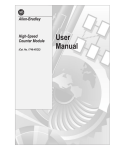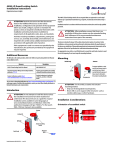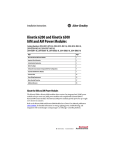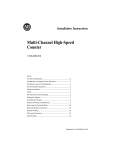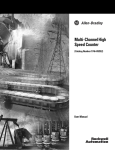Download 1746-IN011, High-Speed Counter Module
Transcript
Installation Instructions High-Speed Counter Module (Catalog Number 1746-HSCE) Inside ................................................................................................Page For More Information............................................................................... 3 Hazardous Location Considerations ........................................................ 4 Environnements dangereux ..................................................................... 4 High-Speed Counter Module Overview................................................... 5 Dip Switch and Jumper Locations ........................................................... 6 Install the Module.................................................................................. 10 Remove the Terminal Block.................................................................... 11 Wire the Removable Terminal Block...................................................... 11 Important Wiring Considerations .......................................................... 12 Input and Output Connections ............................................................... 13 Outputs................................................................................................... 14 Encoders................................................................................................. 15 Single-Ended Wiring (Discrete Devices)................................................ 18 Limit Switch Wiring ............................................................................... 19 Specifications ........................................................................................ 20 Publication 1746-IN011C-EN-P - April 2005 2 High-Speed Counter Module Important User Information Solid state equipment has operational characteristics differing from those of electromechanical equipment. Safety Guidelines for the Application, Installation and Maintenance of Solid State Controls (Publication SGI-1.1 available from your local Rockwell Automation sales office or online at http://www.ab.com/manuals/gi) describes some important differences between solid state equipment and hard-wired electromechanical devices. Because of this difference, and also because of the wide variety of uses for solid state equipment, all persons responsible for applying this equipment must satisfy themselves that each intended application of this equipment is acceptable. In no event will Rockwell Automation, Inc. be responsible or liable for indirect or consequential damages resulting from the use or application of this equipment. The examples and diagrams in this manual are included solely for illustrative purposes. Because of the many variables and requirements associated with any particular installation, Rockwell Automation, Inc. cannot assume responsibility or liability for actual use based on the examples and diagrams. No patent liability is assumed by Rockwell Automation, Inc. with respect to use of information, circuits, equipment, or software described in this manual. Reproduction of the contents of this manual, in whole or in part, without written permission of Rockwell Automation, Inc. is prohibited. Throughout this manual, when necessary we use notes to make you aware of safety considerations. WARNING Identifies information about practices or circumstances that can cause an explosion in a hazardous environment, which may lead to personal injury or death, property damage, or economic loss. IMPORTANT Identifies information that is critical for successful application and understanding of the product. ATTENTION Identifies information about practices or circumstances that can lead to personal injury or death, property damage, or economic loss. Attentions help you: • identify a hazard • avoid a hazard • recognize the consequence SHOCK HAZARD Labels may be located on or inside the equipment (e.g., drive or motor) to alert people that dangerous voltage may be present. BURN HAZARD Labels may be located on or inside the equipment (e.g., drive or motor) to alert people that surfaces may be dangerous temperatures. Publication 1746-IN011C-EN-P - April 2005 High-Speed Counter Module 3 For More Information Related Publications For Refer to this Document Pub. No. A more detailed description on how to configure and program the High-Speed Counter Module. High-Speed Counter Module User Manual 1746-6.5 A more detailed description on how to install and use your modular SLC™ 500 system. SLC 500 Modular Hardware Style Installation and Operation Manual 1747-UM011 A reference manual that contains status file data, instruction set, and troubleshooting information. SLC 500 Instruction Set Reference Manual 1747-RM001 To view and download pdfs, go to Literature Library at http://www.rockwellautomation.com/literature. To order printed copies, contact your Allen-Bradley® Distributor or Rockwell Automation® Sales Office. Publication 1746-IN011C-EN-P - April 2005 4 High-Speed Counter Module Hazardous Location Considerations This equipment is suitable for use in Class I, Division 2, Groups A, B, C, D or non-hazardous locations only. The following WARNING statement applies to use in hazardous locations. WARNING EXPLOSION HAZARD • Substitution of components may impair suitability for Class I, Division 2. • Do not replace components or disconnect equipment unless power has been switched off or the area is known to be non-hazardous. • Do not connect or disconnect components unless power has been switched off or the area is known to be non-hazardous. • All wiring must comply with N.E.C. article 501-4(b). Environnements dangereux Cet équipement est conçu pour être utilisé dans des environnements de Classe I, Division 2, Groupes A, B, C, D ou non dangereux. La mise en garde suivante s’applique à une utilisation dans des environnements dangereux. AVERTISSEMENT DANGER D’EXPLOSION • La substitution de composants peut rendre cet équipement impropre à une utilisation en environnement de Classe I, Division 2. • Ne pas remplacer de composants ou déconnecter l'équipement sans s'être assuré que l'alimentation est coupée. • Ne pas connecter ou déconnecter des composants sans s'être assuré que l'alimentation est coupée. Publication 1746-IN011C-EN-P - April 2005 High-Speed Counter Module 5 High-Speed Counter Module Overview The High-Speed Counter Module, Catalog Number 1746-HSCE is an SLC 500 family compatible device except with the 1747-ASB Remote I/O Adapter Module. It can be used with SLC™ 5/02 (and above) processors. The module’s bidirectional counting ability allows it to detect movement in either direction. In addition, x2 and x4 counting modes are provided to fully use the capabilities of high-resolution quadrature encoders. High-speed inputs from quadrature encoders and various high-speed switches are supported. Accepting input pulse frequencies of up to 50k Hz allows precise control of fast motions. In addition, an Accumulated Counter, the module provides a Rate Counter to determine Rate Measurement by indicating the pulse input frequency in Hz. (See the block diagram on page 6.) The Rate Measurement is determined by accumulating input pulses over a fixed period of time. You set the Rate Period to best match your application requirements. Background Rate calculation is provided in Sequencer and Range Modes. This operation accepts input rates up to 32,767 Hz. The dynamically configurable Rate Period ranges from 10 ms to 2.55 seconds. The module’s four current sink (open collector) outputs can be controlled in the user program or the module. Control of the counter reset is configured through user-set parameters. The counter can be reset from any combination of the Z input, Limit Switch input, or Soft Reset control bits. Module operation is determined by selections made in the Setup and Control Word (M0:e.1). Setting the Function Control bit to 1 triggers the module to start the proper pulse counter, rate measurement, and output control functions. Many parameters are dynamic and can be changed without disrupting counter operation. The module’s block diagram is shown on page 6. Inputs from the terminal block enter the diagram at the left, outputs to the terminal block exit at the right. M0 and Output file parameters from the SLC enter the logic blocks from the top. Input file data to the SLC exit the logic blocks from the bottom. Publication 1746-IN011C-EN-P - April 2005 6 High-Speed Counter Module Dip Switch and Jumper Locations Counter Input Parameters Rate Period Parameters Z LS LS Filter (JW1) Input Logic Rate Counter Pulse and Direction Operating Mode Logic Reset Parameters Reset Logic Rate Counter Inputs Reset Condition Output Control Parameters Rate Measurement Rate Operating Mode Outputs Output Control Logic 4 Physical Outputs Sequencer Pulse Counter Parameters Output Status Inputs Range Pulse Counter Reset Input Bit Counter Input Parameters Input Type (M0:e.1/9–11) Up/Down Count Direction (M0:e.1/3) –d Reset Parameters Soft Reset bit (M0:e.1/4) –d Reset Mode (M0:e.1/5–7) Rate Period Parameters Rate Period (M0:e.9/0–7 or M0:e.16/0–7) –d To Terminal Block From Terminal Block Operating Mode Parameters A B Accumulated Count Operating Mode Inputs Pulse Counter Inputs Pulse Counter Parameters Reset Value (M0:e.34 or M0:e.41) –d Maximum Count Value (M0:e.34 or M0:e.41) Counter Hold bit (M0:e.1/2) –d Counter Type bit (M0:e.1/13) Output Control Parameters Direct Outputs (O:e.0/0–7) –d Output Source Select (M0:e.0/0–7) –d Enable Outputs bit (M0:e.1/1) –d Reset Input bit (I:e.0/12) Operating Mode Inputs Sequencer Inputs Current Sequencer Step (I:e.5/0–7) Next Sequencer Step (I:e.5/8–15) Sequence Done (I:e.0/6) Range inputs Ranges Active (I:e.6/0–11) Output Status Inputs (I:e.4/8–15) Operating Mode Parameters Operating Mode (M0:e.1/14–15) Function Control Bit (M0:e.1/12) Range Definitions: Range Starting Values (M0:e.10 – 33) –d Range Ending Values (M0:e.10 – 33) –d Range Outputs (M0:e.3 – 8) –d Valid Ranges (M0:e.2) –d Sequencer Definitions: Valid Steps (M0:e.2 and M0:e.3/0–7) –d Step Presets (M0:e.17 – 40) –d Step Outputs (M0:e.4 – 15) –d Initial Outputs (M0:e.3/8–15) –d Sequencer Reset (M0:e.1/0) –d Rate Counter Inputs Rate Valid (I:e.0/3) Rate Counter Overflow (I:e.0/4) Rate Measurement Overflow (I:e.0/5) Zero Rate Period Count (I:e.0/2) Rate Period Count (I:e.2) Rate Measurement (I:e.3) Error Inputs Critical Error (I:e.0/10) Configuration Error bit (I:e.0/11) Configuration Error Code (I:e.4/0–7) Pulse Counter Inputs Accumulated Count (I:e.1) Overflow/Underflow (I:e.0/13) Pulse Counter State (I:e.0/14–15) –d indicates a dynamic parameter Two dip switches (SW1 and SW2) and one jumper (JW1) are located on the side of the module. • SW1 selects the type of input (single ended or differential). • SW2 selects the output voltage range (4.5 to 10V dc or 10 to 30V dc). • JW1 selects the filtering rate (300 µs or 10 ms) used to debounce the limit switch input. Publication 1746-IN011C-EN-P - April 2005 High-Speed Counter Module 7 Default settings are shown below: O N 1 234 SW 2 SW 2 JW 1 JW 1 SW2 Default 10 to 30V dc 3 JW1 1 JW1 Default 10 ms filter O N 1234 SW 1 SW1 Default Single-ended ATTENTION Use a small screwdriver to change dip switch positions. Graphite from pencils will damage the switch. Publication 1746-IN011C-EN-P - April 2005 8 High-Speed Counter Module SW2 Settings Select an output voltage range that coincides with your supply voltage. The selections are 4.5 to 10V dc or 10 to 30V dc. ON OFF 1234 10 to 30V dc 1234 ON OFF Switch 1 2 3 4 Output 0 1 2 3 4.5 to 10V dc All switches of SW2 must be ON or all switches must be OFF. Permanent damage may result if some are ON and some are OFF. ATTENTION Operating in the 10 to 30V dc range with the switches set for the 4.5 to 10V dc range damages the module. SW1 Settings Select a single-ended or differential input connection. ON 1234 OFF Dip switch SW1 Position Switch 1 2 3 4 Channel A B Z not used Input Connection Input ON Range ON differential 2.8 to 4.5V dc OFF single-ended 3.1 to 5.5V dc You can configure different inputs in different modes. For example, input A (CHA) can be configured as differential and input Z (CHZ) can be configured as single-ended. Publication 1746-IN011C-EN-P - April 2005 High-Speed Counter Module 9 JW1 Settings Select 300 µs or 10 ms filtering to debounce the limit switch input. Position the jumper as follows: 321 32 1 JW 1 JW 1 10 ms filter 300 µs filter The LS input allows you to make a direct connection to nominal voltage levels of 5, 12, or 24V dc. The ON voltage ranges are as follows: Wiring Terminal ON Range LS (24V dc) 16.5 to 30V dc LS (12V dc) 9.4 to 16.5V dc LS (5V dc) 3.8 to 5.5V dc See page 19 for limit switch wiring instructions. ATTENTION Connect only one LS input range at a time, or the module will be damaged. Publication 1746-IN011C-EN-P - April 2005 10 High-Speed Counter Module Install the Module Installation procedures for this module are the same as for any other discrete I/O or specialty module. IMPORTANT Set the dip switches before installing the module. ATTENTION Disconnect power before attempting to install, remove, or wire the module. Make sure your SLC power supply has adequate reserve current capacity. The module requires 320 mA at 5V dc. Top and Bottom Module Release(s) Card Guide 1. Align the full-size circuit board with the chassis card guide. The first slot of the first chassis is reserved for the CPU. 2. Slide the module into the chassis until the top and bottom latches are latched. Make sure the removable terminal wiring block is attached to the module and all wires are connected to the terminal block. 3. Insert the cable tie in the slots and secure the cable. 4. Cover all unused slots with the Card Slot Filler, Catalog Number 1746-N2. Publication 1746-IN011C-EN-P - April 2005 High-Speed Counter Module 11 Remove the Terminal Block The removable terminal wiring block eliminates the need to rewire a module if it is removed from the chassis. Each terminal accepts two #14 AWG wires. ATTENTION Disconnect power before attempting to install, remove, or wire the removable terminal wiring block. To avoid cracking the removable terminal block, alternate the removal of the slotted terminal block release screws. Remove the terminal block by turning the slotted terminal block release screws counterclockwise. The screws are attached to the terminal block, so it will follow as the screws are turned out. Wire the Removable Terminal Block Use a flat or cross slot screwdriver to tighten terminal screws. Each screw should be turned tight enough to immobilize the wire’s end. Overtightening can strip the terminal screw. Do not exceed 0.7 to 0.9 Nm (6 to 8 in-lbs.). Publication 1746-IN011C-EN-P - April 2005 12 High-Speed Counter Module Important Wiring Considerations Use the following guidelines when planning the system wiring for the module: • • • • • • • • Install the SLC 500 system in a NEMA-rated enclosure. Disconnect power to the SLC processor and the module before wiring. Make sure the SLC 500 system is properly grounded. Group this module and low-voltage DC modules away from AC I/O or high-voltage DC modules. Shielded cable is required for high-speed input signals A, B, and Z. We recommend Belden 9503 or equivalent for lengths up to 305 m (1000 ft). When the LS input is driven by an electromechanical device, route the wiring away from other inputs. In addition, JW1 should be set for the 10 ms filter. When the LS input is driven by a solid-state device, use a shielded cable. You do not have to route the cable away from other inputs. Shields should be grounded only at the end of the signal source end of the cable. Ground the shield to the case of the signal source, so energy coupled to the shield will not be delivered to signal source’s electronics. Publication 1746-IN011C-EN-P - April 2005 High-Speed Counter Module 13 Input and Output Connections Input and output wiring terminals are located on the front of the module, behind the terminal cover. When you connect input and output devices, you must also be concerned with the settings of dip switch SW1 (input connections), dip switch SW2 (output connections), and jumper JW1 (limit switch input connections). The location and description of these are shown on pages 6 through 9. OUTPUT 0 1 2 3 Upper Retaining Screw Maximum Torque = 0.7 to 0.9 Nm (6 to 8 in-lbs) Discrete Output Wiring NOTE: V dc must be externally supplied by the user. See page 14 for output wiring. Terminal Wiring max. 2 wires per terminal max. torque: 0.9 Nm (8 in-lbs) Limit Switch and Encoder Input Wiring See pages 15 through 19 for input wiring. VDC OUT 0 OUT 1 OUT 2 OUT 3 DC COM A+ B+ ABNot used Not used Z+ LS (24 VDC ) ZLS (12 VDC ) LS COM LS (5 VDC ) INPUT 4 5 6 7 A B Z LS FAULT HSCE VDC OUT 0 OUT 1 OUT 2 OUT 3 A+ DC COM B+ ANot Used Z+ ZLS COM BNot Used LS (24V dc) LS (12V dc) LS (5V dc) Lower Retaining Screw Maximum Torque = 0.7 to 0.9 Nm (6 to 8 in-lbs) Publication 1746-IN011C-EN-P - April 2005 14 High-Speed Counter Module Outputs The module features four physical outputs. They can be controlled by the module when certain counter conditions are met, or they can be controlled from the user program (refer to the High-Speed Counter Module User Manual, publication 1746-6.5 for M0:e.0 information). The outputs are bipolar transistors connected in a sinking (open collector sinking) configuration. When the output is energized, it sinks the current. Do not use incandescent lamps as output indicators. The high peak inrush current required to heat the filament can damage the module’s output circuits. Use LED indicators that satisfy the output circuit ratings, such as Allen-Bradley 800A and 800T LED indicators. ATTENTION You can select an output voltage range of 4.5 to 10V dc or 10 to 30V dc. Refer to page 21 for the maximum current specifications for each voltage range. Dip switch SW2, located on the PC board, is used to select the voltage range. See pages 6 and 8 for switch SW2 location and settings. The figure below indicates wiring connections for four 24V dc outputs. All switches of SW2 are OFF for this output voltage. VDC OUT 0 User Supplied 24V dc + OUT 1 - OUT 2 All switches OFF ON OUT 3 DC COM 1 234 OFF Dip Switch SW2 wiring terminals HSCE module The outputs are not electrically isolated from each other. (They are referenced to the same output common terminal.) However, outputs are isolated from the rest of the circuitry to a level of 1500 volts. Publication 1746-IN011C-EN-P - April 2005 High-Speed Counter Module 15 Encoders The wiring diagrams on the following pages are provided to support the Allen-Bradley encoders you may already have. Differential encoders provide the best immunity to electrical noise. Differential Encoder Wiring cable (1) + V DC COM VS GND Belden 9503 or equivalent 305m (1000ft) max length Allen-Bradley 845H Series differential encoder A A(+) A A(-) B B(+) B B(-) Z Z(+) Z Z(-) Power Supply Shield(2) SW1 encoder connector Earth ON 1 2 3 4 OFF (all switches Module Inputs (1) Refer to your encoder manual for proper cable type and length. (2) Due to the topology of the module’s input circuits, terminating the shield at the encoder end provides the highest immunity to EMI interference. Connect EARTH ground directly to the encoder connector housing. Differential Encoder Output Waveforms The illustration below shows the different encoder output waveforms. If your encoder matches these waveforms, the encoder signals can be directly connected to the associated screw terminals on the module. For example, the A lead from the encoder is connected to the module’s A+ screw. If your encoder does not match these waveforms, some wiring modifications may be necessary. Refer to the High-Speed Counter Module User Manual, publication 1746-6.5 for a description of these modifications. A A B B Z Z Publication 1746-IN011C-EN-P - April 2005 16 High-Speed Counter Module Single-Ended Encoder Wiring (Open Collector) cable(1) VS GND + VDC COM Power Supply (3) R Allen-Bradley 845H Series single-ended encoder Shield(2) A A(+) A(-) B B(+) B(-) Z(+) Z(-) Z Belden 9503 or equivalent 305m (1000tft) max length encoder connector housing ON SW1 1 234 OFF (All switches OFF) Module Inputs Earth (1) Refer to your encoder manual for proper cable type and length. (2) Due to the topology of the module’s input circuits, terminating the shield at the encoder end provides the highest immunity to EMI interference. Connect EARTH ground directly to the encoder connector housing. (3) The pullup resistor (R) value depends on the power supply value (VS). The table below lists the resistor values for typical power supply values. These resistors must be located at the encoder end of the cable. VS Value R Value Maximum Output Leakage +5V dc 150 ohm 1/4W 5% 6.3 mA +12V dc 1800 ohm 1/4W 5% 1.5 mA +24V dc 4700 ohm 1/4W 5% 1.2 mA Single-Ended Encoder Output Waveforms The figure below shows the single-ended encoder output waveforms. When the waveform is low, the encoder output transistor is ON. A low = transistor ON high = transistor OFF B Z Publication 1746-IN011C-EN-P - April 2005 High-Speed Counter Module 17 Single-Ended Encoder Wiring (Sourcing) cable(1) VS + VDC COM GND Power Supply Belden 9503 or equivalent 305m (1000tft) max length A(+) A R B(+) B(-) Z(+) R (3) Z(-) B single ended R encoder(4) (3) A(-) Z (3) Shield(2) SW1 ON 1 2 34 OFF (All switches OFF) Earth Module Inputs (1) Refer to your encoder manual for proper cable type and length. (2) Due to the topology of the module’s input circuits, terminating the shield at the encoder end provides the highest immunity (3) The resistor (R) value depends on the power supply value (VS). The table below lists the resistor values for typical power supply values. These resistors must be located at the encoder end of the cable. (4) The Allen-Bradley 845H sourcing encoder is not compatible with this module. VS Value R Value Maximum Output Leakage +5V dc no resistor needed 100 µA +12V dc 1800 ohm 1/4W 5% 100 µA +24V dc 4700 ohm 1/4W 5% 100 µA Single-Ended Encoder Output Waveforms (Sourcing) The figure below shows the single-ended encoder output waveforms. When the waveform is low, the encoder output transistor is OFF. low = transistor OFF high = transistor ON A B Z Publication 1746-IN011C-EN-P - April 2005 18 High-Speed Counter Module Single-Ended Wiring (Discrete Devices) +VDC COM proximity sensor with sourcing output VS OUT COM R1 A(+) A(-) solid-state switch (5V output) VS OUT CO M Power Supply R2 photoelectric sensor with open collector sinking output VS OUT CO M B(+) B(-) Z(+) Z(-) ON 1 2 34 SW1 OFF (All switches OFF) Module Inputs IMPORTANT • This diagram shows the sensors operation from a common power supply. Separate power supplies for each circuit can be used. • The resistor (R1) value depends on the power supply value (VS). The table on page 17 provides the resistor values for typical power supply values. These resistors must be located at the module end of the cable. • The pull-up resistor (R2) value depends on the power supply value (VS). The table on page 16 provides the resistor values for typical power supply values. These resistors must be located at the sensor end of the cable. Publication 1746-IN011C-EN-P - April 2005 High-Speed Counter Module 19 Limit Switch Wiring Connect only one LS input range at a time, or the module will be damaged. ATTENTION 24V dc Hard Contact Hard Contact Limit Switch LS (24V dc) VS 24V dc HSCE module LS (12V dc) LS (5V dc) + - COM LS COM Do not connect LS (5V dc) or LS (12V dc) Terminals 321 Jumper placed for 10 ms filtering JW1 12V dc Hard Contact HSCE module Hard Contact Limit Switch VS 12V dc + LS (24V dc) LS (12V dc) LS (5V dc) - LS COM COM Do not connect LS (5V dc) or LS (12V dc) Terminals 321 JW1 Jumper placed for 10 ms filtering 5V dc Solid State Solid State Limit Switch HSCE module VS VS + 5V dc COM - COM LS (24V dc) OUT LS (12V dc) LS (5V dc) LS COM Do not connect LS (12V dc) or LS (24V dc) Terminals Jumper placed for 300 µs filtering 321 JW1 Publication 1746-IN011C-EN-P - April 2005 20 High-Speed Counter Module Specifications General Description Specification Operating Temperature 0° C to +60° C (+32° F to +140° F) Storage Temperature -40° C to +85° C (-40° F to +185° F) Humidity 5 to 95% without condensation Backplane Current Consumption (power supply loading) 320 mA at +5V dc 0 mA at +24V dc Maximum Cable Length(1) 305 m (1000 ft) Agency Certification (when product or packaging is marked) • • CSA certified CSA Class I, Division 2 Groups A, B, C, D • • UL® listed CE marked for all applicable directives (1) Belden 9503 or equivalent Inputs A, B, and Z Differential (Switch 1 on) Single Ended (Switch 1 off) Input Voltage ±5V dc 0 to 5V dc(2) On-State Voltage 2.8 to 4.5V dc 3.1 to 5.5V dc Off-State Voltage -5.5 to 0.8V dc 0 to 0.8V dc Max Off-State Leakage Current 100 µA 600 µA Input Current (mA) 2.5 mA at 2.8V dc 7.5 mA at 4.5V dc 2.5 mA at 3.1V dc 7.5 mA at 5.5V dc Nominal Input Impedance 700Ω 825Ω Min. Pulse Width 10 µs Min. Phase Separation(1) 4.5 µs Max. Input Frequency Sequencer and Range Rate 50k Hz 32.767k Hz Isolation (from backplane) 1500 volts (1) 12 and 24 volts must be used with a pull-up resistor. (2) Channel A to channel B. Publication 1746-IN011C-EN-P - April 2005 High-Speed Counter Module 21 Limit Switch Input 5V dc 12V dc 24V dc On-State Voltage 3.8 to 5.4V dc 9.4 to 16.5V dc 16.5 to 30V dc Off-State Voltage 0 to 1.2V dc 0 to 2.4V dc 0 to 3.9V dc Input Current minimum nominal maximum 4.6 mA 6.8 mA 9.2 mA Max. Off-State Leakage Current 1 mA (all ranges) Isolation (from backplane) 1500 volts Outputs (Open Collector, Sinking) 4.5 to 10V dc (Switch 2 on) 10 to 30V dc (Switch 2 off) Max. On-State Output Current 16 mA at 4.5V dc 40 mA at 10V dc 40 mA at 10V dc 125 mA at 30V dc Max. On-State Voltage Drop 0.4V dc 1.0V dc Max. Off-State Leakage Current 100 µA Isolation (from backplane) 1500 volts Publication 1746-IN011C-EN-P - April 2005 22 High-Speed Counter Module Publication 1746-IN011C-EN-P - April 2005 High-Speed Counter Module 23 Publication 1746-IN011C-EN-P - April 2005 Rockwell Automation Support Rockwell Automation provides technical information on the Web to assist you in using its products. At http://support.rockwellautomation.com, you can find technical manuals, a knowledge base of FAQs, technical and application notes, sample code and links to software service packs, and a MySupport feature that you can customize to make the best use of these tools. For an additional level of technical phone support for installation, configuration, and troubleshooting, we offer TechConnect Support programs. For more information, contact your local distributor or Rockwell Automation representative, or visit http://support.rockwellautomation.com. Installation Assistance If you experience a problem with a hardware module within the first 24 hours of installation, please review the information that's contained in this manual. You can also contact a special Customer Support number for initial help in getting your module up and running. United States 1.440.646.3223 Monday – Friday, 8am – 5pm EST Outside United States Please contact your local Rockwell Automation representative for any technical support issues. New Product Satisfaction Return Rockwell tests all of its products to ensure that they are fully operational when shipped from the manufacturing facility. However, if your product is not functioning, it may need to be returned. United States Contact your distributor. You must provide a Customer Support case number (see phone number above to obtain one) to your distributor in order to complete the return process. Outside United States Please contact your local Rockwell Automation representative for return procedure. Rockwell Automation, Allen-Bradley, SLC 500, SLC, and TechConnect are trademarks of Rockwell Automation, Inc. Trademarks not belonging to Rockwell Automation are property of their respective companies. Publication 1746-IN011C-EN-P - April 2005 Supersedes Publication 1746-IN011B-EN-P - April 1999 PN 40071-130-01(3) Copyright © 2007 Rockwell Automation, Inc. All rights reserved. Printed in Singapore.



























